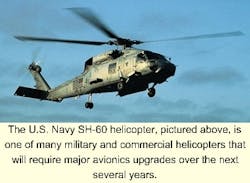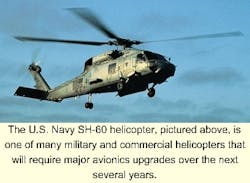By J.R. Wilson
LAS VEGAS - Although helicopter use is forecast to continue increasing through the first decade of the new millennium, operators also are expected to keep each aircraft in service longer than in years past, creating an overall relatively flat market, according to industry prognosticators.
This year's industry forecasts, traditionally put forward by engine manufacturers at the annual Helicopter Association International conference in Las Vegas, came under new names for 2000: Rolls Royce plc of London officially retired the Allison Engine Company name (except for certain mandated US military contracts), while Honeywell Inc. of Minneapolis did the same with AlliedSignal. The only other official forecast was compiled by the Transportation Research Board (TRB), an independent federal advisory panel.
Rolls Royce forecast 9,036 turbine helicopter deliveries worldwide (60 percent civil, 40 percent military) through 2009 - a 1 percent increase from last year's forecast overall, but a 3 percent increase for the military (forecast at 3,633 helicopters). They are the most bullish on the next five years, predicting 2,801 civil deliveries during the first half of the decade.
Honeywell, which only predicts civil sales, was more conservative, forecasting slightly less than 5,300 new helicopters through 2009, with 2,300 of those to be delivered during the next five years, a slight decrease from last year's expectations.
A survey of TRB subcommittee members, representing most manufacturers, suppliers and consultants in the worldwide helicopter industry, splits the difference, seeing a slight downward trend in civil sales during the next five years (2,440 total), followed by a slight recovery during the latter half of the coming decade (2,532). However, their total non-military sales expectations - 4,972 from 2000 through 2009 - is considerably short of the two engine company forecasts.
The TRB members also see a slightly higher demand for light single-engine rotorcraft than is reflected in the forecasts of the manufacturers. They predict about 58.5 percent will be light singles, with light twins a distant second at nearly 21 percent and intermediate twins at 17 percent, leaving large multi-engine helicopters with less than 5 percent of the market.
The forecasts anticipate several positive factors will impact future sales, including increased new operators brought into the market by the sale of surplus military helicopters in recent years. Those initially were expected to hurt new helicopter sales, says Richard Huckle, vice president of customer operations-helicopters for the Rolls-Royce office in Indianapolis. Incomplete or missing records and documentation and lack of support by engine and airframe manufacturers dampened enthusiasm for military surplus in the long term, Huckle says, but expanded the future customer base for new helicopters. That includes 85 new police aviation units in the United States.
"The civil market continues to be supported by new model introductions and a strong economy," Huckle told an HAI news conference in Las Vegas in January. "Increased travel requirements, coupled with airport and airspace congestion, may also result in an increase in the number of corporate operators."
There are some obstacles to corporate expansion, however, including local community opposition to helicopter operations - especially single-engine aircraft - and a growing infrastructure problem. For example, from 1989 to 1999, the number of public helipads in the United States dropped from 214 to 183, according to HAI.
"At this rate, helicopters will increasingly be required to land at airports or at other, less convenient locations, thereby providing a serious challenge to the efficiency of corporate rotary wing travel programs," Huckle warns.
Rolls-Royce officials say single-engine helicopters will continue to dominate the civil market (56 percent of the forecast 10-year sales), with light twins comprising 20 percent of the market and the balance going to medium twins, intermediate twins, and heavy multi-engines.
On the military side, heavy multi-engine rotorcraft dominate the forecast at 45 percent, followed by attack helicopters (28 percent). Medium and intermediate twins, light twins, and single-engine rotorcraft are forecast to comprise an increasingly small portion of the military market after 2003, dropping from about 30 percent of total deliveries expected in 2003 to less than 15 percent in 2009.
"Program delays, budgetary constraints, and changes in some governments' leadership have historically affected the approval and delivery schedules," Huckle says. "There remains what is considered to be a bow wave effect in the military rotorcraft procurement profile, whereby some of the deliveries anticipated earlier in the period will be pushed out two to three years."
Annual flight hours and average hours per helicopter are expected to increase slightly through 2009.
"Fleet age and the recent introduction of important new and derivative helicopter models continue to be important factors supporting current market demand," says Mike Redenbaugh, vice president and general manager for military and helicopter engines at Honeywell Engines and Systems in Phoenix. "We are optimistic about the long-range prospects and future business opportunities for helicopters in this diverse global economy."
Honeywell's percentage expectations for civil helicopter classes roughly parallels those of Rolls-Royce, with the Arizona company anticipating light single engines will comprise about 54 percent of the market, followed by light twins (24 percent), intermediate twins (20 percent) and, at the low end, single- and multi-engine heavy lift helicopters. Those numbers vary considerably within specific geographic regions, however, with a much higher demand for heavy multi-engines in Asia, Oceania, Africa, and the Middle East - with a greater interest in light twins in Europe than in the rest of the world.
North America continues to be the major market for civil sales, accounting for 55.3 percent of Honeywell's five-year baseline forecast, followed by Europe (28.8 percent), Asia/Oceania/Africa/Middle East (8.2 percent) and Latin America (7.7 percent).
Honeywell officials also expect an increase in corporate helicopter sales, accounting for more than 35 percent of their five-year forecast. Following this are emergency medical services (28.6 percent), utility (25.5 percent), law enforcement (21.4 percent), offshore oil (7.1 percent), and broadcast news (1.5 per cent), with some helicopters falling into more than one operational category.




